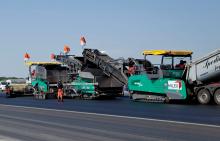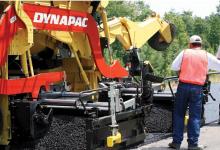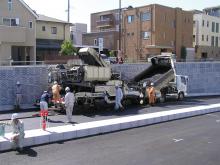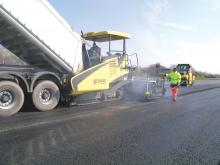Contractors face an array of sophisticated paving technologies, Mike Woof reports. Asphalt paving technology continues to advance as manufacturers develop more efficient and reliable equipment. Paving techniques are also improving, while new polymer modified bitumen materials and recycling methodologies further increase the range of road surfacing options available to the client and contractor.

The Dynapac system features a modified paver with twin screeds while the rival Vögele system uses two adapted pavers
Contractors face an array of sophisticated paving technologies, Mike Woof reports
Asphalt paving technology continues to advance as manufacturers develop more efficient and reliable equipment. Paving techniques are also improving, while new polymer modified bitumen materials and recycling methodologies further increase the range of road surfacing options available to the client and contractor.One of the most notable developments however has been with twin layer technology, where the top two surface layers are laid hot-onhot, in a double paving process.
At present only
The Dynapac and Vögele systems are based on the same principle, of laying the top two layers of a road surface simultaneously, but differ widely in terms of how this is achieved. The principle behind the twin layer paving system is that paving hot on hot ensures a better interbond between the two top layers, increasing potential wear life as the risk of surface failure is reduced.
With better bonding and on-grade compaction, tests show that dual layer paving offers longer lasting surfaces than conventional techniques, even in heavy traffic conditions. Using this method also allows the use of a thin surface wearing course, making substantial reductions in materials costs (because surface courses are the most expensive material grades). Overall this system also cuts the time required for a paving job and for these reasons, offers a costcompetitive solution.
The twin layer paving method also provides greater time for the compaction process as the surface mat remains hot for longer. This is of crucial importance for working in colder climates or winter weather conditions, allowing a greater window for compaction at the jobsite and also offering the potential to increase the months of the year during which paving work can be carried out. As there is only one compaction stage after the single paving operation, it also ensures that there is from a statistical perspective, a reduced risk of subsequent material density problems that would otherwise affect wear life.
Both Dynapac and Vögele say that an experienced paving crew is required to make twin layer paving work effectively. However the companies say that the techniques used do not require a lengthy training process and that any good paving team can be trained to use the equipment in a comparatively short time. The two firms have already paved sections of highway in Germany, the Netherlands and now China (as well as a test strip in the US) and are hoping to widen the market for this technology.
Having two rival systems on the market increases competition and will help boost takeup of the technology, although comparatively few contractors have taken this opportunity so far.
However for new highway construction or major highway resurfacing projects the method offers a speedy surfacing opportunity with major cost and quality advantages.
The Dynapac system, called Compactasphalt, uses a single paver fitted with two screeds and two materials hoppers. The latest version of this is based on a standard large paver, the Dynapac DF145CS unit, with the extra hopper, conveyor system and screed mounted for the twin layer paving application. Dynapac's new CM2500 system is modular in design and with its materials hopper and screed and allows the contractor to pave widths up to 7.5m. However these extra units can be removed comparatively quickly for the machine to be used in conventional paving applications with a single screed, vastly increasing its versatility and utilisation rate for the contractor.
To ensure that compaction is carried out effectively, the Dynapac system does require the use of a special compactor that is based on a standard model but features extra wide drums.
This unit ensures that both layers are compacted, with standard asphalt rollers then being brought into behind to bring the material to grade and provide a quality surface finish.
The Vögele twin layer concept, the InLine Pave system, is based around using two pavers, working close to each other. These are more or less standard machines, but with additional features required for the double layer paving application. As the second machine works directly on the hot asphalt surface, the first unit is based on a Vögele 2100-2 paver and equipped with a special high compaction version of its AB600-2 tamper bar screed that can pave widths of up to 8m. This screed provides up to 98% compaction according to Vögele and ensures that the tracks of the second paver do not cause any deformation on the newly laid surface. Another modification for the first paver is a special transfer module for the surface course mix, which is used to feed into the hopper of the second paver. Meanwhile the second paver also has a sensor array and control system that allows it to work closely to the first unit but prevent the two machines from touching during operation.
For both the Dynapac Compactasphalt and Vögele InLine Pave systems, materials transfer equipment offers the most effective solution to providing a constant flow of asphalt. Dynapac and Vögele build their own materials transfer machines and these have been used for the work carried so far. However contractors buying twin layer paving equipment would also be able to use existing materials transfer machines in their fleets such as the highly successful
There are complimentary technologies that can further improve the efficiency, effectiveness and wear life of the twin layer paving process and although many of these are new on the market, they are already proven across an array of applications.
Dynapac and Vögele both have complimentary compaction equipment ranges (Vögele's sister company is
Running the pavers under machine control systems that combine GPS and total station technology will further improve efficiency. These systems allow the pavers to operate without the need for stringlines, reducing surveying costs and increasing productivity and an array of packages are available from
New materials offer additional benefits while using infrared heating technology will ensure the quality of hot to cold joints and further increase overall road surface life. It is worth noting how poorly many of the Northern Hemisphere's major highway links fared during the recent winter months, with joint failure having been a major cause of potholes in the roadway. Efficient use of twin layer paving techniques coupled with intelligent compaction, advanced machine control and proper use of joint heating equipment could have prevented many highways from failing in these conditions.









